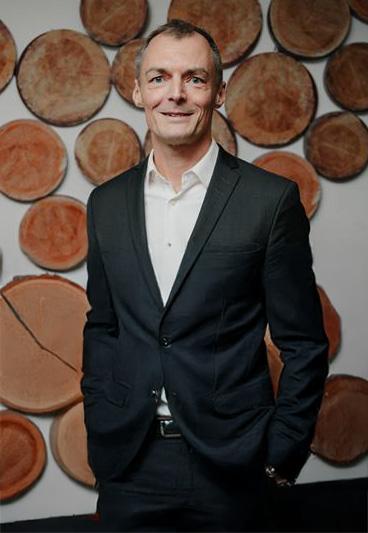While Kanthal is addressing all three, tackling Scope 2 emissions has proven to be one of the most effective levers for progress. By targeting electricity consumption and ensuring it is verified as fossil-free, Kanthal has taken measurable steps to reduce its climate impact and support cleaner industrial value chains.
“During 2025, we plan for several activities to reach a 60 percent reduction in combined Scope 1 and 2 emissions compared to our 2019 baseline,” says Nicolai Schaaf, Sustainability Manager at Kanthal. “And the biggest driver by far was switching to certified fossil-free electricity.”
Why fossil-free electricity matters for Scope 2
 Nicolai Schaaf, Sustainability Manager, Kanthal.Kanthal continues to phase out fossil fuels across its operations, replacing them with electric alternatives wherever feasible. This is the core of mitigating Scope 1 emissions: stopping the burning of fossil fuels. But as Schaaf points out, electrification only reduces emissions if the electricity itself is fossil-free. That’s where energy certificates come in.
Nicolai Schaaf, Sustainability Manager, Kanthal.Kanthal continues to phase out fossil fuels across its operations, replacing them with electric alternatives wherever feasible. This is the core of mitigating Scope 1 emissions: stopping the burning of fossil fuels. But as Schaaf points out, electrification only reduces emissions if the electricity itself is fossil-free. That’s where energy certificates come in.
By sourcing electricity backed by Guarantees of Origin (GoOs) in Europe and Renewable Energy Certificates (RECs) globally, Kanthal has significantly reduced its Scope 2 footprint, without requiring new infrastructure, massive investment, or operational disruptions.
“This was a procurement decision with direct climate impact,” says Schaaf. “We’ve now passed our original 2030 target five years ahead of schedule.”
What energy certificates are and what they’re not
We use energy certificates because they give us a reliable connection between what we consume and how it’s produced.
As the electricity itself, be it from fossil-free or fossil sources, all goes through the same grid, the property of “fossil free” is separated as certificates in a separate market, so-called unbundled certificates. For every megawatt-hour of fossil-free electricity generated, one certificate is issued. These are tracked in regulated systems that follow strict rules and are regularly audited, ensuring a clear chain of accountability.
Kanthal buys and retires such certificates to match the electricity it purchases. This gives the company verified proof that its electricity consumption is based on fossil-free generation.
“We use energy certificates because they give us a reliable connection between what we consume and how it’s produced,” explains Schaaf. “This allows Kanthal to make meaningful and verifiable progress on emissions reductions without delay or disruption.”
How Kanthal applies fossil-free electricity worldwide
Kanthal has used electricity certificates at a few larger sites for several years; other sites have local agreements with suppliers. Now, this principle is made global: Whether in Sweden, the US, or India, if we don’t already purchase certified fossil-free electricity through a local supplier, every site is required to match its electricity purchasing with verified certificates.
“Market conditions vary, but our principles don’t. We hold ourselves to the same standard everywhere,” stresses Schaaf.
It’s not about isolated efforts or standout sites. It’s a company-wide policy that ensures every unit of electricity claimed as fossil-free is supported by clear, auditable proof.
No shortcuts. Just progress.
Between 2019 and 2024, Kanthal achieved emission reductions of 35% in Scope 2 and 27% in combined Scope 1 and 2. The decision to adopt certified fossil-free electricity worldwide, alongside additional electrification projects planned for this year, is expected to result in an estimated 80% reduction in Scope 2 emissions and approximately 60% reduction in combined Scope 1 and 2 emissions.
The goal is to achieve a 90% reduction in total emissions by 2030. This will be accomplished through investments aimed at phasing out combustion processes within our operations. At that point, most remaining emissions will be linked to processes, transportation, facility heating, and a combined heat and power system. We are actively monitoring these areas and implementing electrification wherever feasible.
“Some of the remainder, we might be able to address before 2030; others are a challenge beyond our immediate control. But we will target them with the same clarity and intent that brought us this far,” Schaaf concludes.
Understanding energy certificates
- What they are
One certificate = proof that 1 MWh of electricity was produced from a fossil-free source. - What they enable
Fossil-free electricity use claim is backed by verified, traceable documentation. - How they work
Companies purchase and retire certificates to match consumption. - Why they matter
Without certificates, claims rely on assumptions or averages. - Reporting methods under the GHG Protocol
- Location-based: Uses average grid emissions data
- Market-based: Uses contractual instruments to report purchased electricity
- Why it matters for emissions
The market-based method is the only way to account for fossil-free electricity under global reporting standards.